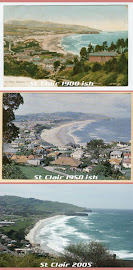Steve Moynihan, of Moynihan Coastal Consulting Ltd, provides some food for thought about the St Clair sea wall.
Quite a lot has been said about the St Clair sea wall.
I have joined the party late, mainly because I have had to carry out some calculations and prepare a drawing.
I am a coastal engineer working from home in Omakau (not because of expected sea-level rise), and I have been involved in new beach design.
Research on many beaches has shown soft (sand/shingle) beaches will adopt an equilibrium shape in plan when adjacent to a headland such as the seawater pool area at St Clair.
Equilibrium is a state where there is no more erosion because the shoreline is everywhere in line with the incoming waves. A beach that has not reached an equilibrium shape will continue to erode until it does so. This is the case at the St Clair corner, which explains why there have been problems there since first occupation in the late 1800s.
The picture published here titled ''Erosion'' has a red line showing where the back of the beach wants to be. In trying to reach this line, the beach may encounter hard rock or a seawall which constrains the back of the beach to the line of the wall.
However, a sea wall does not stop erosion and the seabed in front of the wall will have been continuing to lower until it reaches a depth at the location of the wall, as if the back of the beach did in fact lie along the red line.
The wall would have no problems if it had a strong base that went below the eroded depth, but this would not leave much of a beach in front. Of course the whole situation is very dynamic and sand will come and go, but the overall effect would be that of a poor beach.
A change could be made by pushing out the headland into the sea by way of a breakwater.
The picture labelled ''Beach'' has a yellow line showing where the edge of the beach would lie with a 150m breakwater in place. The result would be a beach of up to 50m width, with the sea wall sheltered by permanent sand.
My inexpert drawing ''Breakwater-Beach'' shows what this would look like. There would be room for activity like beach volleyball. Studies would be required to show no harm to the surf break. More beach could be obtained with a longer breakwater.
The downside is cost. A strong breakwater would be required - costing $8 million to $10 million, depending on whether sand would have to be imported, on final design, studies, and consent costs.
Food for thought anyway.


0 comments:
Post a Comment